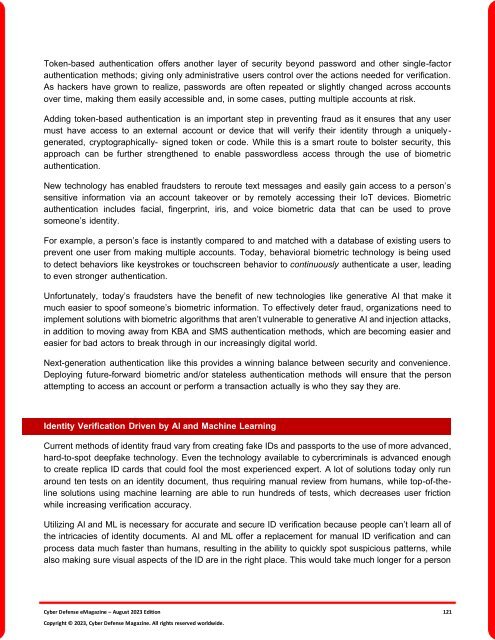The Cyber Defense eMagazine August Edition for 2023
Cyber Defense eMagazine August Edition for 2023 #CDM #CYBERDEFENSEMAG @CyberDefenseMag by @Miliefsky a world-renowned cyber security expert and the Publisher of Cyber Defense Magazine as part of the Cyber Defense Media Group as well as Yan Ross, Editor-in-Chief and many more writers, partners and supporters who make this an awesome publication! Thank you all and to our readers! OSINT ROCKS! #CDM #CDMG #OSINT #CYBERSECURITY #INFOSEC #BEST #PRACTICES #TIPS #TECHNIQUES
Cyber Defense eMagazine August Edition for 2023 #CDM #CYBERDEFENSEMAG @CyberDefenseMag by @Miliefsky a world-renowned cyber security expert and the Publisher of Cyber Defense Magazine as part of the Cyber Defense Media Group as well as Yan Ross, Editor-in-Chief and many more writers, partners and supporters who make this an awesome publication! Thank you all and to our readers! OSINT ROCKS! #CDM #CDMG #OSINT #CYBERSECURITY #INFOSEC #BEST #PRACTICES #TIPS #TECHNIQUES
Create successful ePaper yourself
Turn your PDF publications into a flip-book with our unique Google optimized e-Paper software.
Token-based authentication offers another layer of security beyond password and other single-factor<br />
authentication methods; giving only administrative users control over the actions needed <strong>for</strong> verification.<br />
As hackers have grown to realize, passwords are often repeated or slightly changed across accounts<br />
over time, making them easily accessible and, in some cases, putting multiple accounts at risk.<br />
Adding token-based authentication is an important step in preventing fraud as it ensures that any user<br />
must have access to an external account or device that will verify their identity through a uniquelygenerated,<br />
cryptographically- signed token or code. While this is a smart route to bolster security, this<br />
approach can be further strengthened to enable passwordless access through the use of biometric<br />
authentication.<br />
New technology has enabled fraudsters to reroute text messages and easily gain access to a person’s<br />
sensitive in<strong>for</strong>mation via an account takeover or by remotely accessing their IoT devices. Biometric<br />
authentication includes facial, fingerprint, iris, and voice biometric data that can be used to prove<br />
someone’s identity.<br />
For example, a person’s face is instantly compared to and matched with a database of existing users to<br />
prevent one user from making multiple accounts. Today, behavioral biometric technology is being used<br />
to detect behaviors like keystrokes or touchscreen behavior to continuously authenticate a user, leading<br />
to even stronger authentication.<br />
Un<strong>for</strong>tunately, today’s fraudsters have the benefit of new technologies like generative AI that make it<br />
much easier to spoof someone’s biometric in<strong>for</strong>mation. To effectively deter fraud, organizations need to<br />
implement solutions with biometric algorithms that aren’t vulnerable to generative AI and injection attacks,<br />
in addition to moving away from KBA and SMS authentication methods, which are becoming easier and<br />
easier <strong>for</strong> bad actors to break through in our increasingly digital world.<br />
Next-generation authentication like this provides a winning balance between security and convenience.<br />
Deploying future-<strong>for</strong>ward biometric and/or stateless authentication methods will ensure that the person<br />
attempting to access an account or per<strong>for</strong>m a transaction actually is who they say they are.<br />
Identity Verification Driven by AI and Machine Learning<br />
Current methods of identity fraud vary from creating fake IDs and passports to the use of more advanced,<br />
hard-to-spot deepfake technology. Even the technology available to cybercriminals is advanced enough<br />
to create replica ID cards that could fool the most experienced expert. A lot of solutions today only run<br />
around ten tests on an identity document, thus requiring manual review from humans, while top-of-theline<br />
solutions using machine learning are able to run hundreds of tests, which decreases user friction<br />
while increasing verification accuracy.<br />
Utilizing AI and ML is necessary <strong>for</strong> accurate and secure ID verification because people can’t learn all of<br />
the intricacies of identity documents. AI and ML offer a replacement <strong>for</strong> manual ID verification and can<br />
process data much faster than humans, resulting in the ability to quickly spot suspicious patterns, while<br />
also making sure visual aspects of the ID are in the right place. This would take much longer <strong>for</strong> a person<br />
<strong>Cyber</strong> <strong>Defense</strong> <strong>eMagazine</strong> – <strong>August</strong> <strong>2023</strong> <strong>Edition</strong> 121<br />
Copyright © <strong>2023</strong>, <strong>Cyber</strong> <strong>Defense</strong> Magazine. All rights reserved worldwide.

















